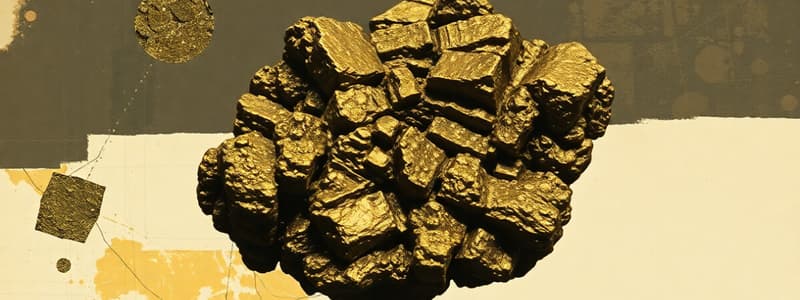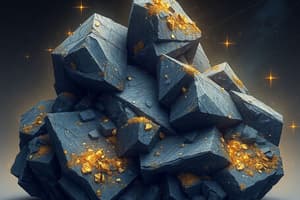Podcast
Questions and Answers
What is a key characteristic that distinguishes pyrite from gold?
What is a key characteristic that distinguishes pyrite from gold?
- Pyrite does not tarnish.
- Pyrite is significantly softer than gold.
- Pyrite forms cubes, while gold forms nuggets. (correct)
- Pyrite is more expensive than gold.
What does the name 'pyrite' derive from?
What does the name 'pyrite' derive from?
- The Latin word for metal.
- The Spanish word for gold.
- The Greek word for fire. (correct)
- The ancient Egyptian word for gem.
Which of the following statements is true about the usage of pyrite?
Which of the following statements is true about the usage of pyrite?
- It is only used in decorative jewelry.
- It is primarily used to create tools for mining.
- It is the main component in gold extraction.
- It is utilized in the bleaching process of the paper industry. (correct)
Which property of pyrite contributes to its vulnerability to tarnishing?
Which property of pyrite contributes to its vulnerability to tarnishing?
What is the main reason individuals in the past mistook pyrite for gold?
What is the main reason individuals in the past mistook pyrite for gold?
What mechanism does pyrite share with gold in terms of appearance, despite differing in composition?
What mechanism does pyrite share with gold in terms of appearance, despite differing in composition?
What visual difference exists between gold and pyrite?
What visual difference exists between gold and pyrite?
In what other application, aside from jewelry, is pyrite utilized?
In what other application, aside from jewelry, is pyrite utilized?
Flashcards are hidden until you start studying
Study Notes
Pyrite: The Golden Doppelganger
- Pyrite, also known as fool's gold, is a metallic mineral that resembles gold in appearance.
- Despite its similarity to gold, pyrite is significantly lighter and forms cubes rather than nuggets.
- Pyrite is commonly found in rocks such as coal, limestone, and dolomite.
- Historically, pyrite's resemblance to gold led to instances of misidentification, causing disappointment for those seeking real gold.
- The name "pyrite" originates from the ancient Greek word for fire, referring to its ability to create sparks when struck against steel.
- Pyrite was historically used for fire-starting and as a mirror.
- In modern times, pyrite has various applications, including use in the paper industry for bleaching, jewelry making, and fireworks.
- While gold is a precious metal with a high value, pyrite is a mineral composed of iron and sulfur.
- Distinguishing gold from pyrite is possible through its properties:
- Gold is softer than pyrite and bends or dents under pressure.
- Pyrite is more brittle and prone to breaking into thin pieces.
- Gold has a warmer yellow tone, while pyrite exhibits a more metallic appearance.
- Gold does not tarnish, whereas pyrite discolors and loses its shine over time.
- Despite not having the same value as gold, pyrite is still a unique and interesting mineral with its own uses and history.
Studying That Suits You
Use AI to generate personalized quizzes and flashcards to suit your learning preferences.


